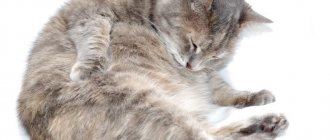(Be the first to vote!)
5589564
07/01/2021 owner reviews
Lately, you've been noticing that your furry friend tends to slide his butt along the floor, which is an iconic dog behavior. Given the erratic nature of cats, you might at first think that your pet is just playing to kill time. However, upon closer inspection, cats often leave behind a brown discharge.
The liquids emit a rather unpleasant odor, leading you to believe that your pet has a serious problem. So, what should pet owners do if they are faced with the problem of brown discharge?
If you are concerned about your pet's health and want to know what is going on, this article is for you. Below, you'll find everything cat parents need to know about the problem of brown poop, from causes to treatment.
Generally speaking, the cat's anal area is vulnerable to a variety of diseases, so pet owners should pay attention to this area. As soon as you notice anything strange, it is extremely important to take your cat to a reputable veterinary clinic for a thorough examination.
- Causes of discharge
- Symptoms of anal sac diseases
- Diagnostics
- What to do
Causes of discharge
Overall, when it comes to the problem of "cat leaking brown fluid", there are several suspects, but anal sac disease is at the top of the list.
FYI: If you lift a cat's tail, you will see two anal glands located slightly below the anus on either side. Because the glands are embedded in muscles, they are difficult to see from afar. In either case, the role of the anal glands is to secrete a yellow-brown fluid when the cat defecates. As you might expect, the smell of liquids is far from pleasant, but cats rely on liquids to mark their territory.
© shutterstock
Usually, a cat's anal glands work as intended, but sometimes something can cause them to produce a thicker-than-normal fluid. Because the pores on the glands cannot drain fluid sufficiently, the glands become larger and larger. After some time, cats will understand what is happening and will try to manually get rid of the fluid in the glands by licking, tugging, ...
If pets can successfully empty their congested anal glands, then everything is fine. On the other hand, if pets can't do anything on their own, people need to step in.
What happens if an owner ignores their cat's plight? Well, pets suffering from anal sac disorder experience severe discomfort that is a direct result of the strange activity of the anal glands. Moreover, when affected cats lick their butts over and over again to cause discharge, they introduce bacteria from their mouth to the area. This means that the risk of urinary tract infection increases dramatically. Finally, the glands may one day burst, causing severe pain, infection and possibly death.
Possible pathologies
Most pathological causes are associated with inflammation and infection of the uterus. This can lead to infertility and even death. To avoid complications, it is necessary to diagnose the existing disease as soon as possible and begin its treatment.
Pyometra
The risk group includes unsterilized animals over 5 years old. Due to hormonal imbalance, pus accumulates in the uterus, so the cat develops copious brownish or cream-colored discharge. Spots of the corresponding color can be seen on the bedding and other resting places of the pet.
The most dangerous form of pyometra is closed. With this disease, the pus does not extend beyond the uterus. This is accompanied by acute pain and enlargement of the abdomen. Over time, the walls of the organ cannot withstand and become damaged. The contents spill into the abdominal cavity, causing the death of the animal.
Endometritis
If a cat's white discharge appeared shortly after birth, then placenta particles could remain in the uterus. Their rotting can provoke endometritis - inflammation of the uterine mucosa. In addition to delayed placenta, the disease can occur due to hormonal imbalance and infection of the genital organs.
The appearance of abundant mucopurulent exudate is accompanied by frequent urination, loss of milk and severe pain. An advanced form of endometritis is fraught with the development of pyometra, infertility and sepsis.
Hematometer
Scanty bleeding in a cat, accompanied by fever and cramping pain, is characteristic of hematometra. With this pathology, blood accumulates in the uterus, since it cannot pass through the endocervix (mucous membrane of the cervix). Narrowing or blockage of the cervical canal occurs due to:
- muscle spasm;
- abortion or miscarriage;
- uterine fibroids;
- congenital anomalies;
- incorrectly performed operations;
- frequent childbirth.
Accumulating blood attracts pathogenic microorganisms. Over time, this leads to purulent inflammation - pyometra.
Hydrometer
With a hydrometer, secretions produced by the uterine glands, transudate and exudate, accumulate in the uterus. If the cervical canal is open or only partially blocked, a small amount of white or clear fluid will leak from the loop. This pathology is most easily detected in a sterilized cat whose discharge is not typical.
Hydrometra is often a complication of the chronic form of endometritis. Over time, the walls of the uterus stretch and become thinner. Scarring and adhesions appear at the site of ruptures. Without timely assistance, death occurs.
Vaginitis
With vaginitis, the walls of the vagina become inflamed and covered with ulcers. The catarrhal-purulent form of the pathology is complicated by an abscess. A sick cat develops a viscous white discharge that resembles thick cream.
The main causes of the disease are a sharp decrease in immunity and postpartum vaginal trauma. Opportunistic bacteria (Escherichia coli, streptococci, staphylococci) living in the body are activated and cause infection.
Other diseases
In addition to the listed diseases, bleeding, copious mucus and pus can be a symptom of several other pathologies. These include:
- Malignant tumors
. Blood appears not only in mucus, but also in urine and feces. As the condition worsens, pus is released. Oncology often occurs due to hormonal imbalances caused by taking drugs to suppress desire. - Blood clotting disorder
. Hematological pathology is accompanied by the appearance of scarlet liquid or clots. - Vaginal phlegmon
. Inflammation affects the subcutaneous fat of the vulva. Due to the gradual growth of the organ, abscesses appear. The pus coming out of the vulva has a mucous consistency. - Uterine trauma
. The appearance of scarlet blood shortly after sterilization is a complication caused by careless surgical intervention. In this case, it is better to call a veterinarian at home, since transporting the animal can aggravate its condition. - Placental abruption or decomposition
. When placental abruption occurs, brown clots appear from the loop. If the kittens die in the womb, the color changes to green. Decomposition adds a strong, unpleasant odor. Bleeding may also occur. If these symptoms occur, you must urgently contact a doctor to prevent the death of the animal.
To identify a possible cause, it is necessary to take into account all accompanying symptoms. If the pet is active, eats well and takes care of the kittens, then you don’t have to worry about her.
Symptoms of anal sac diseases
Once you understand the nature of anal sac diseases, you can easily monitor the symptoms. Because overcrowded glands cause irritation, cats will lick, run, and perform all sorts of tricks to remove fluid from the inside. In extreme cases, cats may resort to scratching and biting for a purpose that is dangerous.
Since a cat's anal glands are only supposed to secrete fluid during bowel movements, any other type of discharge is a problem. Therefore, if you see traces of brown fluid, your pet has an anal sac disorder.
Endometritis
Inflammation of the uterine mucosa. The cause is genital infections. Animals walking on the street, young cats under 3 years of age, when using hormonal drugs for estrus, an unbalanced diet, difficult childbirth, and a hereditary tendency are at risk.
The disease is considered in acute or acquired form. Let's look at the symptoms. In the acquired form, symptoms are mild. The pet looks healthy in appearance, but often licks itself, so the cat’s blood from the uterus is not visible. The danger is that this form can become purulent. This is due to increased accumulation of secretions due to thickening of the uterine mucosa. The secretion is a favorable environment for the development of infections. Characterized by copious discharge and increased body temperature. Urgent medical assistance is required.
Symptoms in acute form
:
- temperature increase;
- loss of appetite;
- copious discharge from the genital opening;
- often arches his back and assumes a posture for urination;
- abdominal enlargement;
- the external genitalia are inflamed.
At an early stage, antibiotics and antimicrobials are used. In case of purulent form, sterilization is carried out. To increase the body's defenses, immunomodulators are prescribed.
Diagnostics
You cannot solve the problem of “brown cat discharge” on your own, so take your pet to a qualified veterinarian. After a couple of questions, your veterinarian will perform a physical test by gently pressing on your pet's glands. Healthy glands should secrete thin yellow fluids, while enlarged glands should secrete thick brown fluids. It is worth noting that you should inform the veterinarian about your pet's condition before admission, such as diarrhea, soft stools,... To rule out other diseases, determine the exact cause and develop an appropriate treatment regimen, the veterinarian will perform chemical testing, including urinalysis, electrolyte analysis, blood test...
© shutterstock
Caring for your cat during treatment
No matter what kind of treatment is carried out, the animal in any case needs increased care and attentive care.
If your pet has undergone surgery, the stitches must be hidden, otherwise the cat may damage them. In order to cover the operation site, you can put a blanket on the animal or make a good bandage.
The diet of a sick pet should be light but nutritious. This is necessary so that the body does not spend a lot of energy on digesting food.
A cat needs to drink even if it doesn't ask. In this case, you can feed her using pipettes or a syringe (without a needle).
A sick animal should have a secluded corner where it can lie quietly. It is necessary to lay a disposable diaper and change it as needed.
What to do
- Swollen glands
In cats with swollen glands, veterinarians first drain fluid with a syringe, clean out the glands, and then administer antibiotics to treat infections. In most cases, your pet can go away after this, but if your cat has chronic swelling, surgical removal of the glands is highly recommended.
In case your cat has strange openings in the anal sac, veterinarians may be able to formulate a treatment regimen based on cyclosporine. Simply put, cyclosporine prevents bacterial infections and is taken orally.
Reminder : Cyclosporine is known to weaken the immune system and, as a result, long-term use of this drug is not recommended. In most cases, it is better to remove the pet's glands instead of controlling the tumor with cyclosporine. Spaying your pet is also a good idea to limit the activity of the anal glands and reduce the frequency of episodes of swelling.
- Torn glands
At this point there is nothing left to do but perform emergency surgery, the vets will remove whatever is left of the glands and clean the area. If the entire operation goes smoothly, the risk of infection should be minimal and a recovery phase will follow. For 1-2 weeks you will need to give your pet an antibiotic prescribed by your veterinarian, but that's it, your pet will be back to his normal self before you know it. As always, return to the clinic periodically to have stitches, staples, etc. removed.
Treatment
Pink discharge in a domestic cat is treated depending on the underlying disease. Treatment can be conservative or surgical. Both methods have been used successfully.
Inflammatory processes in the uterus, kidneys and bladder are treated with antibacterial drugs. Antibiotics are prescribed by a doctor, as some drugs have a negative effect on the animal’s liver or kidneys.
Conservative treatment methods also include physiotherapy. The method is used to eliminate the consequences after surgery or inflammation of the uterus or ovaries.
The chemotherapy method will help to cope with single localized malignant tumors. Usually 1-2 treatment courses help.
Surgery is indicated to remove malignant tumors. And also, if necessary, remove the infected organ if conservative treatment does not produce results. For example, if fragments of the placenta remain in the uterine cavity and they are decomposing, then it is better to remove the organ due to the threat of sepsis.











